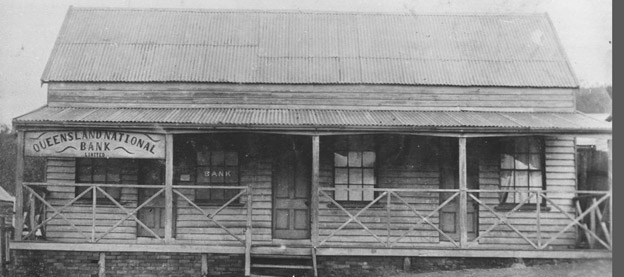
Thornborough was surveyed on 3rd May 1878 by Frederic Horatio Warner. It was the main town for the Hodgkinson gold rush after J. V. Mulligan’s discovery in March 1876.
Warden Mowbray was the first warden here.
The town was named in honour of the then postmaster general.
Byers and Little had the first hotel. Martin’s mill came here from Georgetown.
In 1877-8 there were numerous hotels including William Wright’s Clarance, Harry Wooster’s Exchange, Alf Treventhan’s Overlander, E. D. Matthew’s Tattersalls, William Davidson’s Charters Towers, Peter Middlemiss’ then E. Willick’s Thornborough, James Dowdall’s Thornborough, Wah Lee’s Canton, Geo O’Laughlin’s Queens, J. J. Byers then W.O.D. Condell’s Royal, J.D. Little’s Commercial, R. J. Gorton then J. D. Rowe’s Crown, E. Davis’ Hodgkinson, Khur & Lohmann’s All Nations store and hotel, W. Crisp’s London Hotel and bakery, Lindsay’s Hotel, J.V. Mulligan’s hotel and the Faugh-a-Ballagh which began as Geo Hall’s restaurant then became a hotel under E. Davis. Byers and the Little brothers had a store and a butcher shop.
The stores were owned by K & J Muirson, Saul Mendelsohn, Thompson Solomon, Alexander & Schott which became James Carrie and Co, J. Fagan, Peter Middlemiss, O’Donohue & Greenwood, D. N. Rice, and T. Williams.

The Queensland National and Bank of New South Wales were established. The cordial factory was owned by R. Jones then W. Lawrence then R. Jones & Little brothers. Other business men included: Robert Coulter then Hugh Wason, and James Lees (butchers), Bennett (photographer), Solomon (watchmaker), S. Lipstine (jeweller), S. Kersh (tentmaker), James Badkin (saddler), F. Wittaker and Louis Carmine (bootmakers), J. Hopkinson and W. R. Irwin (chemists), H. G. Hobbs (the doctor), G. Evans, D. McPherson, and Dowding & Harris (all blacksmiths), D. Roberts then T. Willmett & Co (stationer/bookseller), F. P, O’Reilly (solicitor), H. E. Backer (builder), Muldoon Bros & Co (brickmakers), Parker & Vautin (assayers), W. Monteilly and G. J. Willats (auctioneers), and J. S. Brice’s Yankee Shaving Saloon. In 1897 the centre of Chinatown was 300 metres due west of section 8. Apart from the Chinese, Hale, O’Brien, and Wernecke had market gardens.

Working in the area was desultory. Miners left in 1878 for the Coen rush and again to Herberton in 1880. In 1883 the town had five hotels; the Royal, Thornborough, Jockey Club, Commercial, and Canton. The Hodgkinson Miner newspaper was printed from 1877 to 1891 when it moved to Port Douglas as the Port Douglas Gazette. The Hercules crushing mill operated during this period.
By 1902 there were three hotels, Ah Yam’s Canton, J. Gielis’s Commercial, and Grogan’s Royal. Two stores existed, one owned by Grainer. W. Crowley had the butcher shop, Pepper the Assay Office, and Wong Quay the market garden. The Bank of North Queensland existed, along with a school, hospital, post office, police, Catholic Church and the Mining Warden (the Warden’s office having existed there since the earliest days).
By 1920 the Royal hotel had gone and by 1924 only the Canton remained, then owned by Mrs Quill. A post office operated from 1876 until 1931 becoming unofficial from 1921 on. Vince Volkman and his wife now live in Thornborough. The graveyard has been classified by the National Trust.
Year:
1886 – 120
1890 – 35
1894 – 68
1914 – 150
1924 - 100
Text taken from:
1. ‘Angor to Zillmanton: stories of North Queensland’s deserted towns’ by Colin Hooper (2002).
Available Online





